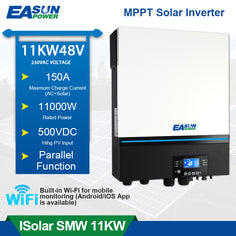When it comes to harnessing solar energy, understanding MPPT technology in solar inverters is crucial for optimizing power output. In this beginner's guide, we will delve into the intricacies of MPPT technology and its significance in solar energy systems.

The Basics of MPPT Technology
Maximum Power Point Tracking (MPPT) is a technology used in solar inverters to maximize the efficiency of solar panels by continuously adjusting the operating point to ensure the maximum power output. This is achieved by constantly monitoring the voltage and current of the solar panels and adjusting the operating conditions to maintain the panel's output at its peak power point.
Understanding MPPT Technology in Solar Inverters is essential for ensuring that the solar panels operate at their maximum efficiency, especially in varying weather conditions and shading effects. By dynamically adjusting the operating point, MPPT technology enables the solar panels to deliver the highest possible power output at any given time.
How MPPT Technology Works
MPPT technology works by continuously tracking the maximum power point of the solar panels, which is the point at which the panel produces the maximum power output for a given amount of sunlight. By adjusting the operating conditions, such as the voltage and current, MPPT technology ensures that the solar panels operate at this optimal point, maximizing the power output.
Understanding MPPT Technology in Solar Inverters involves grasping the concept of the power-voltage curve of solar panels. This curve represents the relationship between the power output and the voltage at different levels of sunlight. MPPT technology utilizes this information to dynamically adjust the operating point of the solar panels, ensuring that they operate at the maximum power point under varying environmental conditions.
Benefits of MPPT Technology
One of the key benefits of MPPT technology is its ability to significantly improve the overall efficiency of solar energy systems. By ensuring that the solar panels operate at their maximum power point, MPPT technology can increase the energy yield of the system, resulting in higher energy production and better return on investment.
Understanding MPPT Technology in Solar Inverters also involves recognizing its role in overcoming the limitations of traditional solar inverters. Unlike traditional inverters, which operate at a fixed voltage, MPPT technology allows for dynamic adjustments, making it more adaptable to changing environmental conditions and shading effects.
Applications of MPPT Technology
MPPT technology is widely used in various solar energy applications, including residential, commercial, and utility-scale solar installations. Its ability to optimize the power output of solar panels makes it an essential component of modern solar energy systems.
Understanding MPPT Technology in Solar Inverters is crucial for anyone looking to harness the full potential of solar energy. Whether it's for powering homes, businesses, or large-scale solar farms, MPPT technology plays a vital role in maximizing the energy production of solar panels.








